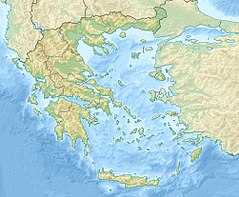Franchthi
| Σπήλαιον Φράγχθι (Greek) | |

entrance to the Franchthi Cave seen from Koilada
|
|
| Alternate name | Frankhthi cave |
|---|---|
| Location | Koilada, Argolis, Greece |
| Region | Argolis |
| Coordinates | 37°25′24″N 23°07′56″E / 37.42333°N 23.13222°ECoordinates: 37°25′24″N 23°07′56″E / 37.42333°N 23.13222°E |
| History | |
| Periods | Paleolithic to Neolithic |
| Site notes | |
| Public access | yes |
Franchthi cave or Frankhthi cave (Greek: Σπήλαιον Φράγχθη) is a cave overlooking the Argolic Gulf opposite the village of Koilada in southeastern Argolis, Greece.
The cave was occupied from the Upper Paleolithic circa 38,000 BCE (and possibly earlier) through the Mesolithic and Neolithic periods, with occasional short episodes of apparent abandonment. Last occupied around 3,000 BCE (Final Neolithic), it is one of the very few settlements in the world that shows nearly continuous human occupation for such an extended period of time, and is one of the most thoroughly studied sites from the stone age in southeastern Europe.
Professor T.W. Jacobsen, Professor of Classical Archaeology and Classical Studies at Indiana University, began excavations at Franchthi Cave in 1967. The dig was only intended to temporarily occupy Jacobsen, and his fellow researcher, M.H. Jameson, for one short season, while they waited for land use issues to be resolved at a nearby site. But it soon became clear that Franchthi cave was more important than they had anticipated. The excavation, overseen by Jacobsen, would continue for nearly a decade, ending in 1976. Since then numerous scholars have examined the extensive finds.
During much of its history Franchthi was significantly further from the coastline than it is today, due to lower sea levels that have since risen around 400 ft. Thus, its inhabitants looked out on a coastal plain that was slowly submerged over the course of their occupation.
During the Upper Paleolithic Franchthi Cave was seasonally occupied by a small group (or groups), probably in the range of 25 - 30 people, who mainly hunted wild ass and red deer, carrying a stone tool kit of flint bladelets and scrapers. Its use as a campsite increased considerably after the Last Glacial Maximum (LGM), with occasional hiatus in the sequence of occupation.Obsidian from the island of Melos appears at Franchthi as early as 13,000 BCE, offering the earliest evidence of seafaring and navigational skills by anatomically modern humans in Greece. (There is evidence that suggests ancient mariners - such as Homo Erectus or Homo Heidelbergensis - may have reached Crete at least 130,000 years ago.)
...
Wikipedia


